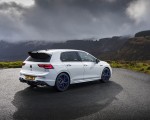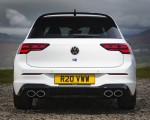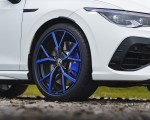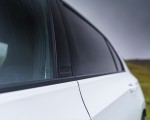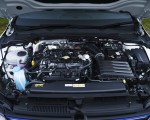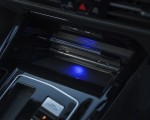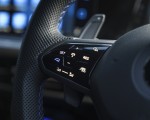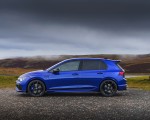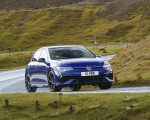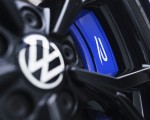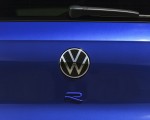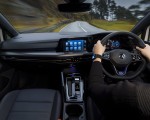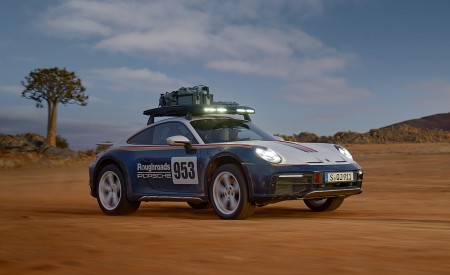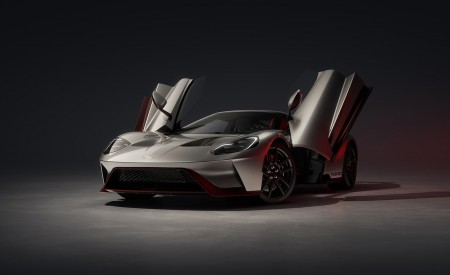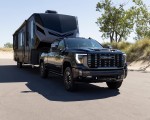2022 Volkswagen Golf R 20 Years (UK-Spec)
Volkswagen is an acknowledged leader in the field of high-performance family cars. Creator of one of the first 'hot hatches' in the shape of the original Golf GTI more than 40 years ago, now the pinnacle of Volkswagen performance comes in the form of its R-branded models. The first Volkswagen to bear the revered R badge was, of course, a Golf and now the brand is marking two decades since that first potent machine made its debut with the arrival of nothing less than the most powerful and fastest production Golf yet created: the Golf R '20 Years'. Recognising the landmark anniversary, the Golf R '20 Years' is a tribute to, and celebration of, the sheer enthusiasm for practical yet compelling performance that has been the hallmark of each and every R-badged model.
To deliver on its promise of creating a car capable of serving up 'the extraordinary, every day' the Volkswagen R team needed to dig deep into its track-developed technologies for the VW Golf R '20 Years'. In doing so the team has fashioned not only a hot hatch worthy of the 20th anniversary occasion, but also a car that represents the zenith of current Volkswagen series production performance.
The statistics speak for themselves: power in the Golf R '20 Years' is upped once more, exceeding even that of the current Golf R's already breath-taking 320 PS, to stand at 333 PS. The 2.0 16-valve turbocharged EA888 powerplant, here in new evo4 guise, generates 420 Nm of torque channelled through a seven-speed DSG transmission and metered by R-Performance Torque Vectoring – a development used in conjunction with Volkswagen's highly regarded 4MOTION all-wheel drive – to bespoke 235/35 R19 Bridgestone tyres. This arrangement catapults the Golf R 20 Years to 62 mph in only 4.6 seconds and, in the UK, the derestricted top speed of 168 mph promises exhilarating track day excitement. This is the fastest accelerating, most potent production Volkswagen yet offered.
A global performance car phenomenon, the R brand has sold in excess of 300,000 models worldwide in the '20 years' since that first Golf R debuted. Moreover, the UK remains a key market for the R badged suite of Volkswagen models. No surprise, then, that there is significant interest in the Golf R '20 Years' among knowledgeable and enthusiastic buyers nationwide. This sixth iteration of the Golf R in the model's 20-year history not only celebrates an important anniversary, but represents a time-limited opportunity for enthusiasts and collectors to snap up what may well be viewed in years to come as a true icon of the internal combustion era. Production of the Golf R '20 Years' at Volkswagen's Wolfsburg HQ in Germany will cease in mid-2023.
As with every production Golf the new, limited production run, model exhibits the practicality, safety features and state-of-the-art technologies that make every example of Volkswagen's biggest-selling car such a popular choice. Despite it's heroic performance potential the car remains a practical proposition. This five-door, five-seat family hatchback can accommodate up to five adults in considerable comfort measuring as it does 4,290 mm long; 1,451 mm tall and 1,789 mm wide. The wheelbase is a sizable 2,628 mm, the boot measures 341 litres with all seats in place and, when the asymmetrically split rear seat backrest is folded down simply and easily, that load capacity increases to a maximum of 1,197 litres.
At launch in the late autumn of 2022, the Volkswagen Golf R '20 Years' arrives in one five-door hatchback bodystyle and with a single 2.0-litre turbocharged engine and 7-speed DSG transmission combination. With fuel economy of 35.8 mpg and CO2 emissions of 175 g/km (combined), the Golf R '20 Years' is mindful, too, of its environmental impact.
Technical and safety highlights
The Mk 8 Golf represents nothing less than a digital revolution in the family car class, and it has succeeded in creating a new level of interaction between human and vehicle.
Across the Golf family, and of course featuring here in the Golf R '20 Years', the current generation of instruments form a crystal clear Innovision Cockpit; online infotainment and navigation systems become interactive; and standard-fit state-of-the-art Car2X communication technology allows the Golf to link up with its environment to warn of local hazards well in advance.
Aside from the Car2X technology present in all new Golfs, several of the car's other systems are not only connected to each other but, thanks to an online connectivity unit (OCU), they are also connected to the world outside the car. The standard OCU featuring integrated eSIM links to Volkswagen's now familiar We Connect and We Connect Plus online functions and services.
As a best-selling model in Europe, and a regular feature of the top ten sales list in the UK, the current Volkswagen Golf brings many important new technologies emphatically to the masses.
Car2X
This generation of Golf is the first Volkswagen model to feature Car2X communication. This exciting system allows the exchange of information between other Car2X-equipped vehicles, as well as the road infrastructure, traffic situation, hazards on the road and much more. Car2X applies information provided by other vehicles and signals from the traffic infrastructure within a radius of up to 800 metres to warn drivers of hazards. It can also forward these warnings to other Car2X-equipped models. It is fitted as standard to every Golf in the UK.
Car2X works simply, and extremely effectively. Information is exchanged within milliseconds thanks to the application of a harmonised Car2X standard across the European Union. This standard will, in time, be applied by other manufacturers, too, meaning it will be possible to transfer information between vehicles from different car makers as well as the roadside infrastructure.
In developing Car2X Volkswagen has opted to use Wi-Fi-based communications rather than connect via the 5G network. This communication allows the Golf to register a wide variety of potential hazards ranging from accidents on the road to broken-down vehicles, the tail end of traffic jams, roadworks, emergency braking and the nearby presence of emergency service vehicles. Specifically, when emergency service vehicles are detected, the system's hazard alert allows the Golf to provide its driver with targeted, precise information about the distance and direction of approaching Car2X-equipped ambulances, fire engines and police vehicles. This means the driver can react in good time and, if circumstances allow, even pull over to make space for the emergency service vehicle.
Vehicles that have broken down or been involved in an accident can also highlight their potentially hazardous situation by issuing a virtual warning triangle that is displayed in other Car2X-equipped vehicles' cockpits. Meanwhile the car's brake lights can also be used by Car2X in a new way. If vehicles driving in front of the new Golf brake sharply, the brake lights of Car2X-equipped models behind it are automatically activated before the brakes are even applied. This means that drivers behind the Golf are best placed to react significantly earlier than they might otherwise do.
Innovision Cockpit
The Golf's digital instruments, delivered via a standard-fit 10-inch display, and online Discover Navigation infotainment system – merge to form what is a class-leading digital information system. This consistent digital architecture, with information provided on a single visual axis, also sees light and vision functions redesigned, bundled and made more intuitive to operate. For instance, the car's colour-changing interior lighting as well as the windscreen and rear window demisting functions are now operated using a digital panel to the left of the instruments. The centre console sees the inclusion of touch pad sliders for the air conditioning system and infotainment system, a shift-by-wire gear knob for the automatic dual clutch gearbox (DSG), while the new roof console now includes a touch slider for the optional tilting and sliding panoramic sunroof. A windscreen head-up display is optionally available to further enhance the range of information on offer.
Intuitive Voice Control
It's possible to interact with the Golf R '20 Years' via the "Hello Volkswagen" natural voice control function. Instinctual operation means the system is activated simply by saying "Hello Volkswagen" or pressing the voice button on the steering wheel. The Golf responds with "Yes, please?" and "What would you like to do?" and reacts to intuitive voice commands, such as "Go to Milton Keynes" (navigation) or "I'm cold" (automatic air conditioning). New, digital microphones not only ensure clearer voice recognition and voice quality for phone calls, but also locate the person who is speaking, either driver or front passenger. It is possible, therefore, to simply and easily control the navigation system, air conditioning system, phone and infotainment system with voice commands.
IQ.LIGHT LED matrix headlights
This advanced system debuted in the eighth generation of Golf, with interactive light technology significantly improving driving safety at night. One of three available LED headlight versions, this top-of-the-range system is standard on the Golf R '20 Years'. Activated by the driver via Dynamic Light Assist it uses 22 LEDs per each headlight matrix module to offer up to ten different, partly interactive, light functions and projects them onto the road surface ahead. The sweeping indicator function of the IQ.LIGHT LED matrix headlights is another first for this iteration of Golf, and is proven to have a positive effect on active safety by virtue of its striking looks.
The variety of lighting formats on offer via the system includes: dipped headlight (activated on the basis of speed); main beam (activated on the basis of speed); cornering light (activated on the basis of steering wheel angle or turn signal, or when reversing); poor weather light (activated by the Golf's driver); motorway light (activated on the basis of speed and GPS data); dynamic cornering light in City Light, dipped headlight, motorway light, main beam and partial main beam (activated on the basis of steering wheel angle); sign glare control (activated on the basis of dazzling sensors in the front camera); City Light (activated on the basis of speed and GPS data); partial main beam (activated on the basis of dazzling sensors in the front camera) and travel mode (switching between left-hand and right-hand traffic, activated by driver in the vehicle menu). With IQ.Light fitted the Golf R '20 Years' brake lights also feature a striking switchover function between LED signatures – a so-called 'click-clack' effect – while sweeping indicators of course also feature at the rear of the car.
Windscreen head-up display
Via the optionally available head-up display – a first in class for this Golf – important information such as speed or navigation instructions are clearly shown in the driver's field of vision. The head-up display is projected onto the windscreen and appears to virtually float in front of the driver.
Dynamic Chassis Control (DCC)
Optionally available on the Volkswagen Golf R '20 Years', DCC responds continually to changing driving situations and takes braking, steering and acceleration into account. The required damping is calculated for each wheel and adjusted at the four shock absorbers within fractions of a second. Using a new digital slider, the driver can individually and precisely set and store their exact personal driving profile. The slider also continuously influences the lateral dynamics of the Golf via DCC and XDS, so it is now also possible to apply intermediate settings in between the familiar modes. The Golf also offers additional new adjustments, exceeding the capabilities of previous systems. (For more on dynamics see the 'engine, transmission and running gear' section).
ACC with predictive speed detection
Adaptive Cruise Control in the Golf is predictive. This means the system calculates the position of the car based on route and GPS data from the navigation system to lower its speed before reaching bends, roundabouts, junctions, speed limits and built-up areas. At the same time, ACC accesses the Dynamic Road Sign Display via the front camera and adjusts the speed as soon as a limit has been detected.
Front Assist
The familiar Front Assist system offers impressive functionality in Golf Mk 8. The area monitoring system, using a radar sensor and in conjunction with the front camera, warns and brakes in emergency situations using the City Emergency Braking System and Pedestrian Monitoring functions, and operates even at very low speeds in built-up areas. In this iteration of Golf, it is augmented by the addition of Cyclist Monitoring, swerve support and – for the first time in a Volkswagen – oncoming vehicle braking when turning function.
Oncoming vehicle braking when turning
When the new Golf turns right (in the UK), crossing a line of opposing traffic, the car is capable of braking to a stop (while simultaneously emitting an audible and visual warning) if there is an oncoming vehicle approaching in the opposing lane. Depending on the speed at which both vehicles are travelling this new function can, within system limits, prevent a near head-on accident or work to mitigate its consequences.
Trim level, equipment, and options
The new, limited production run, Golf R '20 Years' arrives in the UK with a single five-door, five-seat hatchback bodystyle and one, generous, standard specification reflecting its highly desirable 'collector's item' market position.
With a packed specification list containing an unrivalled selection of features and equipment the enhanced model is loaded with the very latest, cutting-edge Volkswagen technologies. Thanks to the now familiar modular transverse matrix (MQB), the Golf R '20 Years' sets the benchmark when it comes to safety and driving comfort. It is equipped with extensive assist systems such as Travel Assist with Lane Assist, Front Assist, Side Assist and the especially bright IQ.LIGHT LED matrix headlights with Dynamic Light Assist advanced main-beam control.
Four driving profiles – Comfort, Sport, Race and Individual – carry over from the Golf R and, by virtue of the '20 Years' standard-fit R-Performance package, it gains two additional driver modes: Drift and Special (Nürburgring). The latter is tuned specifically for the Nordschleife track at the Nürburgring – not only one of the world's most challenging racing tracks but also the location of the final tuning round for all Volkswagen R models. Drivers use a menu to adjust the ESC to their requirements by selecting one of two settings. ESC can also be switched off completely for all driving situations (ESC off mode), however, the Autonomous Emergency Braking Front Assist and the Swerve Support reactivate the full ESC system in an emergency.
In the cockpit touch buttons, touch sliders and touch screens substitute the functions of classic controls and analogue displays. The R-specific Digital Cockpit Pro – standard fitment on the Golf R '20 Years' – offers exclusive features such as a new, horizontal engine speed display at the upper edge of the digital display as well as a lap timer for track sessions. The Digital Cockpit Pro's 10" high resolution TFT screen offers customisable displays that can show the likes of boost pressure, gearbox temperatures, torque distribution and much more. The steering wheel features an 'R' button so that the driver can switch between driving profiles without taking their hands off the wheel.
Options include Dynamic Chassis Control (DCC) variable suspension settings with a choice of modes. Individual mode allows fine-tuning of the dampers with 15 different settings. Other available upgrades include an 'Akrapovic' titanium sport exhaust system – a low density and high strength titanium exhaust system saving 7kg in weight, with round twin tailpipes left and right and valve control system – a panoramic sunroof; Park Assist; and Head Up Display.
Building on the already generous specification of every new Golf R, which includes a veritable cornucopia of standard features, the limited run Golf R 20 Years adds yet further equipment. Among its many highlights are Lane Assist with Road Edge Recognition; dynamic road sign display; Travel Assist with Emergency Assist and Side Assist with Rear Traffic Alert; ACC Adaptive Cruise Control including Front Assist, radar sensor-controlled distance monitoring system, city emergency braking system, cruise control and speed limiter; Car2X intelligent vehicle networking; Digital Cockpit Pro with 10" high resolution TFT dash display screen; sports seats with integrated headrest in `Nappa leather' and front and outer rear seats with `R` logo in upper backrest; high quality decorative trim in genuine carbon fibre on dash panels and door trims; active climate control front seats (heated and ventilated with active climate control); an Emotion Start function which activates an initial engine speed overshoot extending up to 2,500 rpm and 19-inch 'Estoril' Black, black or blue surface alloy wheels (body colour dependent).
Engine, transmission and running gear
Upgraded and exclusive to the VW Golf R '20 Years' the 2.0 (1,984 cc) EA888 evo4 turbocharged petrol engine produces peak power of 333 PS – the most power yet offered by any production Volkswagen model – with its torque peak of 420 Nm arriving between 2,100 rpm – 5,500 rpm. A 7-speed DSG transmission is solely offered with this engine, while standard-fit 4MOTION all-wheel drive and R-Performance Torque Vectoring System allow optimal grip in all scenarios. The Golf R '20 Years' accelerates to 62 mph in just 4.6 seconds, and pushes on to a derestricted top speed of 168 mph. Fuel economy stands at 35.7 mpg on the combined cycle, while CO2 emissions of 175 g/km are also measured.
7-speed DSG
The DSG (Direct Shift Gearbox) dual-clutch transmission, available only as a 7-speed in the Golf R '20 Years', connects two independent gearboxes under load to the engine in turn, depending on the current gear, via two drive shafts. An output shaft assigned to each gearbox applies the torque to the driven wheels via the differential gear. Clutches and gearboxes are operated hydraulically by the gearbox mechatronics (a combination of mechanics and electronics). The electronic transmission control unit, sensors and hydraulic control unit form one compact unit. The control unit uses information such as engine speed, road speed, accelerator position and driving mode to select the optimum gear and to determine the ideal shift point. The control unit then implements the shift commands in a sequence of precisely co-ordinated actions. DSG can also be used manually, via the gear lever or paddle shifts.
Ergonomically shaped DSG paddles are located on the rear of the sports steering wheel in the Golf R '20 Years' and when driving, the new gearshift system responds with noticeable feedback in the form of a sporty shifting jolt to manual upshifts. This deliberately perceptible feedback from the gearbox and drivetrain is active for manual upshifts in the S & S+ gear selector positions.
4MOTION all-wheel drive with R-Performance Torque Vectoring
The 4MOTION all-wheel drive system in the Volkswagen Golf R '20 Years' means drive torque is distributed between the front and rear wheels via an electronically controlled multi-plate clutch, and is regulated according to various factors such as the engine's momentary torque output. This distribution is need-based – the focus here is on always maintaining optimal traction, and thereby driving safety. Moreover, a newly developed rear axle also distributes drive power variably between the left and right rear wheels. The new 4MOTION all-wheel drive system with R-Performance Torque Vectoring function means that up to 100 percent of the possible torque can be directed to the wheel on the outside of the bend. This reduces the cornering radius and understeer is reduced which, in turn, leads to noticeably more agile vehicle handling. As with all 4MOTION applications, under low engine drive torque conditions, or during kick-down, forward propulsion comes primarily from the front axle, while the rear axle is partially decoupled. This basic drive configuration saves fuel. If necessary, the rear axle can be variably engaged within fractions of a second.
Optimised front axle and steering
Lowered by 20 mm in comparison with the standard model, the sports running gear for the Golf R and now Golf R '20 Years' has been retuned specifically for the vehicle. The focus was on achieving outstanding performance while still retaining the best possible ride characteristics. In the basic layout, the running gear consists of a McPherson front axle and a four-link rear suspension. The DCC application has also been adapted accordingly, with the running gear engineers modifying the system's hydraulics and programming. The running gear team increased the negative camber (-1°20') on the front axle to allow higher cornering speeds and also increased lateral guidance. This also results in a much more neutral vehicle response in overrun mode and during acceleration. A rigidity-optimised aluminium subframe helps to reduce the weight of the front axle while the transverse link mounts and hub carriers on the Golf R's rear axle have also been modified compared to that of a standard Golf. At the same time, the response of the progressive steering has been made more direct when steering into bends. The yaw response is characterised here by a higher degree of linearity right up to high speeds – this can be perceived continuously the driver, and there is also more "road feedback" when cornering.
Vehicle Dynamics Manager
Volkswagen's new driving dynamics control system, fresh for the Golf 8, is the Vehicle Dynamics Manager. In the Golf R and Golf R '20 Years', the intelligent system not only closely integrates the electronic differential locks (XDS) and lateral dynamics-related elements of the optionally controlled shock absorbers in the adaptive chassis control system (DCC), but also – for the first time – the 4MOTION all-wheel drive system with R-Performance Torque Vectoring.
Electromechanically adjustable running gear systems significantly enhance the balance between maximum dynamics and the optimum comfort. The Vehicle Dynamics Manager works by continuously coordinating the electromechanical functions of the all-wheel drive system, the electronic differential locks (XDS), and the lateral dynamics-related elements of the regulated shock absorbers (DCC). The system adapts individual wheel damping 200 times a second, thereby guaranteeing particularly agile and accurate handling. The Vehicle Dynamics Manager also enables exact calculation of perfect clutch control for the selective wheel torque control function to further optimise the agility and stability of the Golf R '20 Years'. In parallel, targeted braking intervention on the side of the vehicle closest to the inside of a bend further reduces understeer.
Vehicle Dynamics Manager helps to reduce roll (via DCC) while the car vehicle responds faster to even the slightest movement of the steering wheel via DCC and 4MOTION with R-Performance Torque Vectoring. Traction is improved by an increased locking torque in the selective wheel torque control, and vehicle handling is slightly more biased towards the rear. The system also cleverly optimises yaw and load change damping at high speeds via 4MOTION with R-Performance Torque Vectoring and DCC.
Since the Vehicle Dynamics Manager now monitors the Golf R '20 Years' handling on every corner, it is able to specifically correct understeer or oversteer. If, for instance, a driving manoeuvre causes the Golf R to understeer too heavily on a corner and results in the front end being pushed outwards – during spontaneous acceleration ahead of the apex of the bend, for example – the Vehicle Dynamics Manager closes the selective wheel torque control clutch on the wheel located on the outside of the bend. The result is that yaw is generated on the rear axle, which turns the Golf R neutrally into the bend and reduces understeer.
Dynamic chassis control (DCC)
This optional chassis control system continuously reacts to the road surface and driving situation while taking account of various elements including steering, braking and acceleration manoeuvres. In the Golf R and Golf R '20 Years', the lateral dynamic components of the DCC running gear are coordinated and thus further optimised by the Vehicle Dynamics Manager. Via the selected driving profile, the driver can influence the reduction in body motion as desired. The required damping is calculated for each wheel and adjusted at the four shock absorbers within fractions of a second. This ensures that DCC provides optimum ride comfort and ideal driving dynamics in conjunction with the Vehicle Dynamics Manager.
Driving profiles
The VW Golf R '20 Years' comes with the familiar Comfort, Sport, Race and Individual profiles – as well as new profiles offered in conjunction with the standard-fit R-Performance package: Special and Drift. The Sport profile is the dynamically ideal 'basic' driving mode while, unsurprisingly, the Comfort profile is tailored more for a higher degree of ride compliance yet still offering steering precision. In the Race profile, implemented especially by Volkswagen R for the Golf R, the coasting function (freewheeling without drive power) is deactivated, the engine sound is increased via the exhaust valves, and the DSG, DCC, progressive steering and the all-wheel drive system are adjusted to a sportier setup.
The two new profiles, available via the R-Performance package and offered as standard in the Golf R '20 Years', are extensions of the Sport profile. The 'Special' setting has been specifically configured for the Nürburgring Nordschleife and adjusts a softer setup of the DCC running gear compared to Race mode, for example, to make sure this high-performance car maintains maximum contact with the road on the undulating Nordschleife. The dynamic chassis control is configured here with a special vertical setup; a bespoke tune optimised for lateral dynamics is also achieved via the Vehicle Dynamics Manager and selective wheel torque control so that the vehicle handles the corners of the Nürburgring as efficiently as possible. Furthermore, downshifts in automatic DSG mode – performed depending on the brake pressure – complement every deceleration ahead of corners. Depending on the lateral acceleration and the speed with which the accelerator is released ("Fast Off"), the current gear is also maintained.
In manual DSG mode, the otherwise usual forced upshifts also no longer apply. For the turbocharged engine, this means that the load changes are adjusted in order to optimise steering response and lateral dynamics. In addition, the engine speed is increased to improve the performance when pulling away and the accelerator characteristic is adapted for optimum control.
In Drift profile, the parameters for the ESC change to ESC Sport and the distribution of power via the all-wheel drive system enable the Golf R to drift when driven on private tracks. To ensure that the profile is only selected on private roads, the infotainment system always displays a confirmation prompt before it is activated.
Individual ESC control
When the Golf R or Golf R '20 Years' is started, ESC is always active as a full system. However, drivers of the most powerful production Golfs yet built can adapt ESC in two stages. In ESC Sport mode, the ESC thresholds and ASR slip thresholds are increased to reduce the intensity of interventions. In ESC Off mode, experienced drivers can additionally deactivate ESC altogether for all driving situations. However, Front Assist and Swerve Assist reactivate the full ESC system in the event of an emergency.
Progressive steering
Progressive steering is fitted as standard in the Golf R and Golf R '20 Years'. This system has also been enhanced for these cars as the running gear engineers set up the progressive steering ratio more directly while applying new software algorithms and a new software application.
The system works, in its simplest terms, by applying a progressive gear ratio. This significantly reduces the effort required to steer when manoeuvring and parking. On winding country roads and when turning off a main carriageway, the driver will notice a greater dynamic response thanks to the more direct setup. It also means that the driver does not have to change their hand position as frequently.
In terms of technology, progressive steering is essentially differentiated from the basic steering system by virtue of its variable steering rack and pinion gearing as well as a more powerful electric motor. In functional terms, this means that unlike systems with a fixed steering ratio, which are always forced to compromise between driving dynamics and comfort, the teeth of the steering rack vary significantly over the range of the steering movement. As a result, the transition between a comfortable steering response in the centre range (driving straight ahead) and direct steering response for larger steering wheel turn angles has been set up progressively to enable a more agile steering response in more dynamic driving.
18-inch brakes
To make sure this Golf can be brought to a controlled halt from its derestricted 168 mph top speed, an appropriate front-axle brake system with 18-inch brake discs is fitted. The 18-inch brakes feature disc dimensions of 357 mm x 34 mm, and the brakes themselves are built with pin discs and a brake pot made of aluminium for reduced unsprung mass. A speed-dependent map in the electromechanical brake servo ensures precise brake control. Thanks to precise optimisation the brakes still permit exact control even just before ABS intervention. A large brake master cylinder ensures crisp, precise response in combination with sporty and short brake pedal travel. The specific tuning of the brake pedal characteristic also supports this sportier and more direct brake pedal feeling. The brake system is characterised by its blue brake callipers and 'R' logo.
Design
The Golf's design has always been considered a benchmark in terms of form and function – and so it is with the Mk 8 car, which benefits from the model's carefully crafted design DNA.
For seven generations and over half a century the Golf's design has been enhanced, refined and in parts reinvented. Adeptly merging everyday usability with clear-cut, accurate design, today's Golf is a prime example of aesthetically perfect design and function.
Externally, the dominant design element is the C-pillar: a distinctive element of this and every Golf. It makes the body dynamic towards the front, concentrates it towards the rear and transfers the iconic shape of the original Golf into the present.
The Volkswagen Golf R '20 Years' builds on this solid base with a suite of design enhancements tailored to clearly but elegantly mark this out as a rare and special machine. The blue R logo immediately catches the eye on the black radiator grille of the Golf R '20 Years'. The logo can also be found on both wings and on the boot lid.
The standard-fit 19-inch Estoril alloy wheels also indicate that this is an extra special Golf. The spokes are diamond-cut, and the outer surfaces in the new Black/Blue colour variant create a sporty contrast. The wheel rims can also be optionally ordered completely in Black. The exterior mirror caps are blue (except when the exterior colour is Lapiz Blue, in which case they are black).
When the vehicle is unlocked, the driver and front passenger are greeted as standard with the "20 R" logo projected onto the ground via puddle lamps beneath the door mirrors. Meanwhile a subtle "20" badge on the B-pillars underscores this car's rarity.
At the back, this special-edition model is equipped with a roof spoiler that underlines the motorsport look, projecting as it does well beyond the roof edge. In combination with the black surround extending towards the rear window, this gives the Golf R '20 Years' an even more planted look and emphasises the vehicle's dynamics. The blue R logo on the boot lid and the tinted windows at the rear sides and rear round off the sporty appearance of the flagship model.
Interior: quality by design
Inside, as out, today's Golf is a masterclass in ergonomic efficiency. As spacious as it is smart, the Golf 8's interior focuses on function and practicality, without sacrificing style and comfort. Naturally, the Golf R '20 Years' builds on this with a selection of exclusive design elements. The blue "R" logo on the case of the vehicle's key immediately indicates that this is a special car, a fact underscored by the "20 Years" logo projection specific to this special-edition model which welcomes drivers from beneath the door mirrors as they enter the car.
Decorative trim elements fashioned from genuine carbon fibre in the door side trims and on the dash panel are a first for Volkswagen, and further underline the special ambience of this anniversary car. As befits a premium offering, the VW Golf R '20 Years' boasts premium sport seats up front. Upholstered with 'Nappa' leather and feature active climate control the seats bear the blue R logo embroidered into the upper part of the backrest, while the blue used in the interior matches the Lapiz Blue metallic paintwork typical for Volkswagen R models.
Dimensions
As with every Golf Mk 8, this car appears capacious yet dynamic, although its compact dimensions make it supremely practical around town. It measures 4,290 mm long, 1,789 mm wide and 1,451 mm high. The wheelbase totals 2,628 mm.
Cd-optimised exterior mirrors, aerodynamic corners and spoiler in the rear roof section, extensive underbody panelling, and aerodynamically optimised features in the wheel housing liners with displacement elements at the front and spoilers at the rear underscore the efficient shape.
Crucially, practicality has not been sacrificed. Even in Golf R '20 Years' guise the Mk 8 remains a capacious five-seat all-rounder. The car offers plenty of room for five people, along with a 341-litre luggage compartment capacity in this seat configuration. When the asymmetrically foldable rear seat backrest is folded down, the load capacity increases to a maximum of 1,197 litres.
Servicing and warranty
Volkswagen offers customers a choice of servicing regime for their Golf. They can choose Fixed Service or Flexible Service and the appropriate selection is dependent on how the car is likely to be driven and its general use.
The Fixed Service regime is recommended for vehicles that will cover less than 10,000 miles in 12 months and if the vehicle is likely to be used in the following way:
- Predominantly urban driving, short journeys with frequent cold starts
- Activities regularly producing high engine loading, for example frequent hill climbs, driving with vehicle fully loaded and towing
- Driving with high rpm, hard acceleration and heavy braking. In this case, the vehicle will be serviced at regular intervals, at every 10,000 miles or every 12 months
Flexible Service is recommended for vehicles with a daily mileage of more than 25 miles, where the vehicle is driven regularly and on mainly longer distance journeys. The vehicle should be mainly driven at a constant speed with minimum vehicle and engine loading, minimal towing and driven in an economical manner.
In this case, the on-board computer informs the driver via a dashboard display, when the vehicle needs a service. A range of engine sensors electronically monitors the vehicle's oil temperature, oil pressure, oil level and brake pad wear to establish when a service is needed. With the Flexible regime, the vehicle can cover typically up to 18,600 miles (approx) or 24 months (whichever is sooner) between oil changes. An inspection service is typically due in the third year of ownership or at 40,000 miles and thereafter every second year for vehicles with an annual mileage of around 10,000 miles.
Customers can choose between Fixed and Flexible at PDI (pre-delivery inspection) and though it is possible to change from one to another during the vehicle's lifetime it can only be done when a full inspection service is due.
Warranty
The Golf has a three-year (first- and second-year manufacturer operated, third-year retailer-operated) / 60,000-mile mechanical warranty. In addition, it comes with a 12-year body protection guarantee, three-year paint warranty and a year's membership of Volkswagen Assistance which includes European breakdown cover. The latter can be extended at minimal cost to the customer.

















